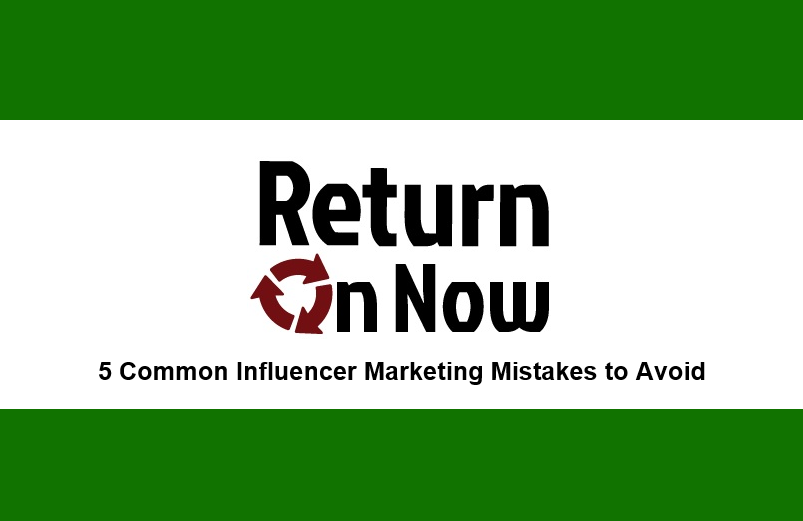In today’s digital age, influencers are hot property. Because of this fact, influencer marketing has become the fastest growing customer acquisition method.
Brands, who once spent their time chasing celebrities instead, are now turning to influencers to endorse their products.
Collective Bias proved this point in a recent study, which revealed that 30% of consumers are more likely to purchase a product endorsed by a lesser well-known blogger, as opposed to a celebrity.
So, what makes influencer marketing tick? In a world cluttered with brand content, consumers want nothing more than authenticity.
And so, they are more likely to engage with and value the opinions of influencers instead.
While brands continue to jump on the influencer marketing bandwagon, how many are actually doing it right?
Here are 5 common influencer marketing mistakes you should avoid in order to run a successful campaign:
Focusing On Follower Count
Focusing strictly on how many followers an influencer has is the most common mistake businesses make while choosing an influencer to promote their brand.
An influencer will not be automatically suitable for your specific campaign just because he or she has 100,000 followers. Similarly, don’t remove any potential options from your list just because they only have 30,000 followers or less.
If you have decided to spend your hard earned money on the campaign, you need to be extremely careful while selecting the influencer. Take time to dig into the finer details.
Do thorough research, including:
- Go through the prospective influencer’s pages
- Study the kind of content they post
- Check whether your brand fits in with their audience and tone of voice
- Look at the kind of engagement they get on their posts
- Scan their comments and check to see if they are genuine in their responses
These are some areas you should explore to make a better informed decision.
Setting Unclear Goals
Like every campaign you run, this one needs to have clear goals and objectives. What are you trying to achieve from this influencer campaign?
Are you spreading awareness about a new product, creating buzz about a promotional offer, increasing social engagement, or driving clicks to your website?
This is a start, but you need to do more than just setting influencer marketing goals. Share these goals with the influencer to ensure everyone is on the same page.
Remember – the influencer’s efforts will be as good as your input. Set expectations from the beginning and clearly communicate the campaign KPIs for best results.
Failing to Involve the Influencer
Influencer collaboration is all about building valuable relations. It is a two-way street.
You shouldn’t expect to call all the shots just because you are the one spending the money.
Once you have gotten an influencer on-board, you need to work together with him/her to chalk out a content plan for your campaign.
It’s a good idea to work on a mini content calendar and be aware of what content is going up on which platform, and when it will be posted.
Make sure you aren’t the overpowering marketer trying to control every step. Respect the influencer for the platform they have built and trust their judgement.
Let’s face it, they know what works best with their followers. That’s why you engaged with them in the first place.
Overdoing the Branding and Pitching
While the purpose of the campaign is obviously to draw attention to your brand, don’t overdo it by plastering that communication all over the influencer’s posts.
The beauty of influencer marketing lies in its authenticity and subtlety. Try to seed the message within their content, such that it flows very organically.
By treating it as another piece of branded content, you will never be able to maximize the potential of this trending marketing tool.
So, educate the influencer about your brand/product and make them aware of the key message you want to communicate. But in the end, let them give the campaign his/her unique spin.
Not Measuring Results
As with all campaigns, it is important to measure the effectiveness of the influencer campaign in light of the goal(s) you had set out to achieve. Link each objective to a metric, and reflect back on the success of it after completion.
For example, if you wanted to drive clicks to your website, insert tracking links to understand if you got any traffic from the influencer’s posts.
Similarly, if increasing social engagement was the objective, track how your fan base has increased with the help of social media analytics tools.
Definitely make it a point to measure the campaign effectiveness, as it tells you how the campaign fared and the impact it had. This will help you learn from your mistakes and improve your influencer marketing efforts in any future campaigns.
From spreading brand awareness and enriching your SEO to building trust and loyalty – influencer marketing can be incredibly beneficial for your brand, if done correctly.
So, avoid these common mistakes. Approach influencer marketing relations with trust and transparency. After all, it is a mutually beneficial relationship, and how you manage it is crucial to the campaign’s success.
Adela Belin
Latest posts by Adela Belin (see all)
- 5 Common Influencer Marketing Mistakes to Avoid - July 3, 2018





